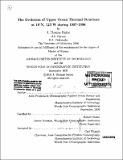| dc.contributor.advisor | Robert Weller. | en_US |
| dc.contributor.author | Farrar, J. Thomas (John Thomas), 1976- | en_US |
| dc.contributor.other | Woods Hole Oceanographic Institution. | en_US |
| dc.date.accessioned | 2010-09-03T18:52:27Z | |
| dc.date.available | 2010-09-03T18:52:27Z | |
| dc.date.copyright | 2003 | en_US |
| dc.date.issued | 2003 | en_US |
| dc.identifier.uri | http://hdl.handle.net/1721.1/58442 | |
| dc.description | Thesis (M.S.)--Joint Program in Oceanography/Applied Ocean Science and Engineering (Massachusetts Institute of Technology, Dept. of Earth, Atmospheric, and Planetary Sciences and the Woods Hole Oceanographic Institution), 2003. | en_US |
| dc.description | Includes bibliographical references (p. 181-191). | en_US |
| dc.description.abstract | In this thesis I have endeavored to determine the factors and physical processes that controlled SST and thermocline depth at 10⁰N, 125⁰W during the Pan Amer- ican Climate Study (PACS) field program. Analysis based on the PACS data set, TOPEX/Poseidon sea surface height data, European Remote Sensing satellite wind data, and model simulations and experiments reveals that the dominant mechanisms affecting the thermocline depth and SST at the mooring site during the measurement period were local surface fluxes, Ekman pumping, and vertical mixing associated with enhancement of the vertical shear by strong near-inertial waves in the upper ocean superimposed upon intra-seasonal baroclinic Rossby waves and the large scale zonal flow. | en_US |
| dc.description.statementofresponsibility | by J. Thomas Farrar. | en_US |
| dc.format.extent | 191 p. | en_US |
| dc.language.iso | eng | en_US |
| dc.publisher | Massachusetts Institute of Technology | en_US |
| dc.rights | M.I.T. theses are protected by
copyright. They may be viewed from this source for any purpose, but
reproduction or distribution in any format is prohibited without written
permission. See provided URL for inquiries about permission. | en_US |
| dc.rights.uri | http://dspace.mit.edu/handle/1721.1/7582 | en_US |
| dc.subject | Joint Program in Oceanography/Applied Ocean Science and Engineering. | en_US |
| dc.subject | Earth, Atmospheric, and Planetary Sciences. | en_US |
| dc.subject | Woods Hole Oceanographic Institution. | en_US |
| dc.subject.lcc | WHOI 2003 .F3 | en_US |
| dc.subject.lcsh | Thermoclines (Oceanography) | en_US |
| dc.subject.lcsh | Ocean-atmosphere interaction | en_US |
| dc.title | The evolution of upper ocean thermal structure at 10⁰N, 125⁰W during 1997-1998 | en_US |
| dc.type | Thesis | en_US |
| dc.description.degree | M.S. | en_US |
| dc.contributor.department | Joint Program in Oceanography/Applied Ocean Science and Engineering | en_US |
| dc.contributor.department | Woods Hole Oceanographic Institution | en_US |
| dc.contributor.department | Massachusetts Institute of Technology. Department of Earth, Atmospheric, and Planetary Sciences | |
| dc.identifier.oclc | 54958828 | en_US |
